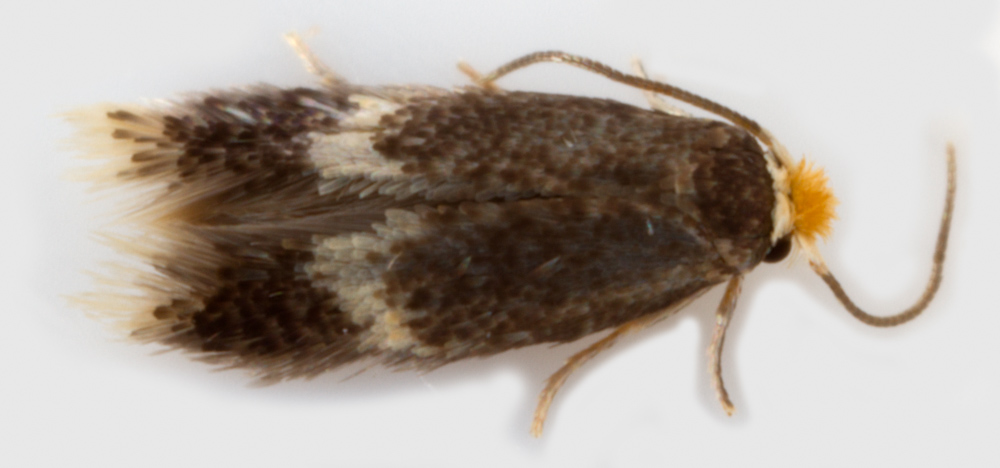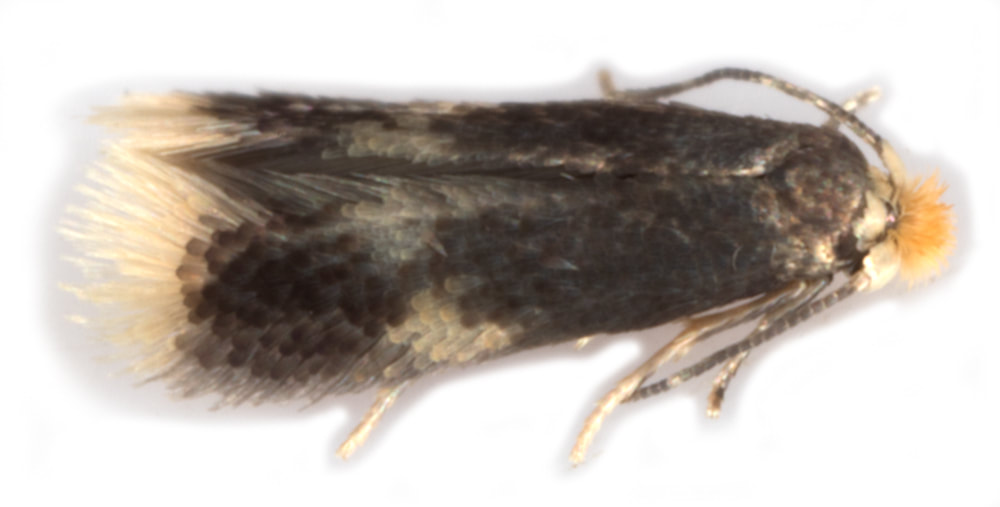04.035 Stigmella salicis (Sallow Dot)
ws: 4-6mm; bivoltine Apr-May, Jul-Aug, mine rough-leaved sallows (Salix spp) Jun-Jul, Sep-Nov; common throughout GB
ID: Group B - forewing with a pale fascia but no pale spots. Using the key in MBGBI1 - terminal cilia abruptly whitish beyond a line of dark-tipped scales; fascia yellowish-white, not metallic; apical cilia of forewing more yellow than cilia of hindwing; fascia yellowish (not whitish!), beyond middle, outwardly oblique; basal area of forewing fuscous (with little yellow showing); ws 4-6mm, fascia distinct, aedeagus without long hooked cornuti.
Similar species considered here are all in the Salicis Group of MBGBI1. They all have a ferruginous-yellow head, whitish collar and eye-caps. There are differences in flight season: S.obliquella - May & Aug, S.myrtillella - May-Jun & Aug - so specimens found in Apr and Jul should be S.salicis, those found in Jun should be S.myrtillella, and those found in May & Aug could be any of these three.
S.myrtillella is distinguished in the key in MBGBI1 by having a (narrower) whitish rather than a yellowish fascia! - this seems entirely unconvincing and I think this species would be impossible to separate from S.salicis on external features. As far as I can determine, a difference in habitat/proximity to the foodplant may be the only means of distinguishing adult S.myrtillella/salicis.
Male genitalia: The key and the text in MBGBI mentions that there is a long ventral prolongation of the vinculum in S.myrtillella, but this is not convincingly illustrated in the figures (fig 67, p227 and fig 58, p237) and images at Moth Dissection suggest that this is a variable feature in both species (or perhaps it varies with the degree of compression of the specimen). These illustration show the cornuti to be fairly evenly sized and absent from the apical third of the aedeagus in S.myrtillella, while in S.salicis the cornuti are more variable in size and evenly distributed through the whole aedaegus. However, comparing images of both species at Moth Dissection there does not appear to be any convincing difference in this feature between the species. Similarly the gnathos, pseuduncus, transtilla and valval apices appear indistinguishable.
Female genitalia: Not illustrated in MBGBI1 and only S.salicis is shown at Moth Dissection. The female genitalia shown here as S.myrtillella appear indistinguishable from those at Moth Dissection shown as S.salicis.
S.obliquella: In the key in MBGBI1, S.salicis is most similar to S.vimineticola, which is said to be smaller (ws 4-5mm - so larger specimens should be S.salicis, but smaller specimens cannot be determined by size); with a narrow, indistinct fascia and with long hooked cornuti in the aedeagus. This difference in the genitalia is illustrated on p227. However - in the description of S.vimineticola doubt is cast over its occurrence as a British species. In the RES handbook S.vimineticola is synonymised under S.obliquella. in the key S.obliquella is distinguished by having the forewing fascia central and transverse ("more or less central, hardly outwardly oblique"). Despite mentioning the similarity between S.salicis and S.obliquella, the genitalia of S.obliquella are not mentioned or illustrated in MBGBI1. The male genitalia of both species are shown at Moth Dissection. The image of S.obliquella does show 1 long and 1 shorter very narrow hooked cornuti in the base of the aedeagus (the illustration of S.vimineticola in MBGBI1 places the hooked cornuti near the apex of the aedeagus!). I have found the cornuti very difficult to see and even more difficult to adequately image. There does seem to be a difference (shown in both the images at Moth Dissection and the illustrations in MBGBI1) in the separation of the juxta lobes and the uncus lobes both of which are closer together in S.obliquella than in S.salicis.
Similar species considered here are all in the Salicis Group of MBGBI1. They all have a ferruginous-yellow head, whitish collar and eye-caps. There are differences in flight season: S.obliquella - May & Aug, S.myrtillella - May-Jun & Aug - so specimens found in Apr and Jul should be S.salicis, those found in Jun should be S.myrtillella, and those found in May & Aug could be any of these three.
S.myrtillella is distinguished in the key in MBGBI1 by having a (narrower) whitish rather than a yellowish fascia! - this seems entirely unconvincing and I think this species would be impossible to separate from S.salicis on external features. As far as I can determine, a difference in habitat/proximity to the foodplant may be the only means of distinguishing adult S.myrtillella/salicis.
Male genitalia: The key and the text in MBGBI mentions that there is a long ventral prolongation of the vinculum in S.myrtillella, but this is not convincingly illustrated in the figures (fig 67, p227 and fig 58, p237) and images at Moth Dissection suggest that this is a variable feature in both species (or perhaps it varies with the degree of compression of the specimen). These illustration show the cornuti to be fairly evenly sized and absent from the apical third of the aedeagus in S.myrtillella, while in S.salicis the cornuti are more variable in size and evenly distributed through the whole aedaegus. However, comparing images of both species at Moth Dissection there does not appear to be any convincing difference in this feature between the species. Similarly the gnathos, pseuduncus, transtilla and valval apices appear indistinguishable.
Female genitalia: Not illustrated in MBGBI1 and only S.salicis is shown at Moth Dissection. The female genitalia shown here as S.myrtillella appear indistinguishable from those at Moth Dissection shown as S.salicis.
S.obliquella: In the key in MBGBI1, S.salicis is most similar to S.vimineticola, which is said to be smaller (ws 4-5mm - so larger specimens should be S.salicis, but smaller specimens cannot be determined by size); with a narrow, indistinct fascia and with long hooked cornuti in the aedeagus. This difference in the genitalia is illustrated on p227. However - in the description of S.vimineticola doubt is cast over its occurrence as a British species. In the RES handbook S.vimineticola is synonymised under S.obliquella. in the key S.obliquella is distinguished by having the forewing fascia central and transverse ("more or less central, hardly outwardly oblique"). Despite mentioning the similarity between S.salicis and S.obliquella, the genitalia of S.obliquella are not mentioned or illustrated in MBGBI1. The male genitalia of both species are shown at Moth Dissection. The image of S.obliquella does show 1 long and 1 shorter very narrow hooked cornuti in the base of the aedeagus (the illustration of S.vimineticola in MBGBI1 places the hooked cornuti near the apex of the aedeagus!). I have found the cornuti very difficult to see and even more difficult to adequately image. There does seem to be a difference (shown in both the images at Moth Dissection and the illustrations in MBGBI1) in the separation of the juxta lobes and the uncus lobes both of which are closer together in S.obliquella than in S.salicis.
§1 Arne, Dorset; 06/07/2016; male; fw 2.5mm
§2 Dungeness, Kent; 12/07/2018; male; fw 2.5mm
§3 Dungeness, Kent; 13/07/2018; male; fw 2.7mm
§4 Removed to S.myrtillella
§5 Removed to S.myrtillella
§6 Removed to S.myrtillella
§7 Covert Woods, Kent; 09/05/2022; male
§8 Removed to S.myrtillella
All images © Chris Lewis
§2 Dungeness, Kent; 12/07/2018; male; fw 2.5mm
§3 Dungeness, Kent; 13/07/2018; male; fw 2.7mm
§4 Removed to S.myrtillella
§5 Removed to S.myrtillella
§6 Removed to S.myrtillella
§7 Covert Woods, Kent; 09/05/2022; male
§8 Removed to S.myrtillella
All images © Chris Lewis
Page published 07/08/2016 (§1) | §2&3 added 25/05/2019 | §4-6 added 20/10/2019 | §7 added 21/08/2022 | §8 added 01/12/2022 |
§4,5,6&8 re-identified as S.myrtillella and removed 24/05/2024
§4,5,6&8 re-identified as S.myrtillella and removed 24/05/2024
















